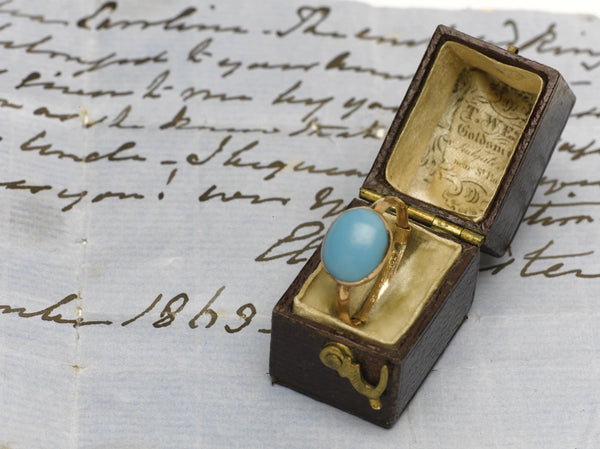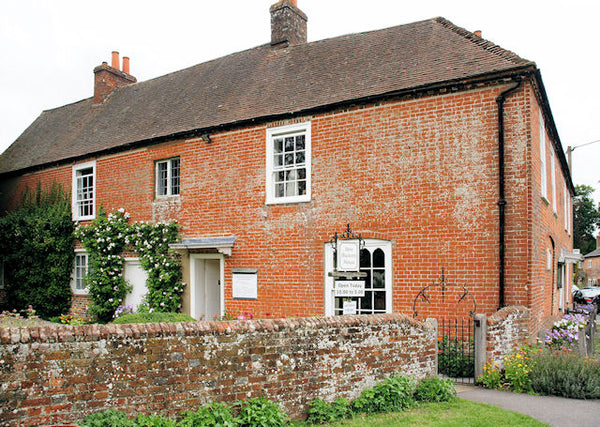Jane Austen is a legend of British literature. Over 200 years after their publication, novels like Pride and Prejudice, Emma, and Sense and Sensibility continue to enchant readers worldwide. Likewise, the late Georgian Regency era in which Austen lived remains widely used in popular culture.
But Austen's legacy extends far beyond her gripping tales. Her style — particularly her jewellery — is popular with fans and collectors. In particular, a turquoise ring that belonged to Austen has gained an almost mythical reputation. This piece, alongside a collection of her remaining jewellery, offers us a unique glimpse into the everyday life of a literary icon.

What was fashion like in Jane Austen's time?
During Jane Austen's era, fashion epitomised grace and refinement. The late 18th century featured elaborate dresses, shifting towards more understated pieces in the 1790s and early 1800s. Garments of the time introduced trends like the Empire waist, positioning the waistline just beneath the bust.
This style celebrated the body's natural contours, embracing flowing designs, lightness and simple colours. Today, these styles are reflected in popular culture, such as Jane Austen's television adaptations and shows like Bridgerton. We’ve seen an enormous demand for similar dresses in the recent “Regencycore” fashion trend.
What is regency-era jewellery like?
The jewellery of the Regency period complemented the elegant gowns. Pieces were designed to bring grace and sparkle without overwhelming the charm of the entire outfit.
Georgian Regency-era jewellery took a balanced approach to design. We saw a spectrum of styles — from some opulent pieces to mostly restrained, intricately detailed works that celebrated the fascination with natural beauty. Nature-inspired motifs, such as flowers and leaves, were widespread, showcasing the period's fondness for the outdoors.
The gemstone selection of the time reflected a more localised industry. Gems like amethyst were highly prized. Scottish agate and Portuguese topaz were also popular choices, underlining the era's appreciation for stones with distinct origins. The use of turquoise in jewellery added a vibrant touch, further accentuating the period's diverse and nuanced approach to decoration. Pearls, diamonds and cameos were likewise popular choices.
This diversity in design means a wide range of Georgian-era rings exist today, with something to suit every taste.
What jewellery did Jane Austen wear?
Reflecting her relatively simple life and modest income, Jane Austen did not own a vast jewellery collection. However, a few pieces survive. Among them are a topaz cross (with her sister, Cassandra, owning one as well), a bracelet, and — most famously — the turquoise ring. There is also a brooch containing Jane's hair.

Jane Austen’s turquoise ring
Jane Austen's gold ring, set with a turquoise stone, is a cherished relic. It’s not often we find pieces that once adorned the hand of one of Britain's most esteemed figures, after all. This ring, encapsulating the Regency period’s elegance and simplicity, features an oval cabochon blue stone of natural turquoise within a 9-carat gold band.
For such a well-known figure, it’s actually a relatively simple ring. But its striking turquoise set against classic gold makes for a memorable and desirable piece of jewellery.
This is a similar ring we've previously sold, valued at £1,500.

In terms of deeper meanings, the ring's dainty design and small sizing hint at Austen's petite stature. Meanwhile, turquoise rings feature the birthstone for December, aligning with Austen’s birthdate.
Sam Mee, founder of Antique Ring Boutique, explains that turquoise is actually a gem, not a colour: "It's a bright blue to greenish stone that is cryptocrystalline, meaning that it is actually made of millions of tiny crystals, invisible to the naked eye. It has a long and distinguished history, and is one of the most famous stones of the ancient world, prized by the Egyptians, the Aztecs and the rulers of Shang dynasty China.
"Turquoise was thought to have general protective qualities, and rumoured to discolour if its owner’s health was declining.
"The stone’s name ‘turquoise’, now synonymous with its famous colour, originally derives from the French turquois, meaning ‘Turkish’, as most stones traded in Europe were sourced in Iran, and then were imported via Turkey.
"Turquoise was highly valued in Georgian jewellery, as even in small cabochons, the stone is strikingly bright and vivid. This rare 18th century treasure is a rare survival of a jewel in this style, in closed-back settings typical of the period. Especially as turquoise are among the more fragile materials used for rings."
What happened to Jane Austen’s turquoise ring?
Following Jane’s death, her belongings were inherited by her sister Cassandra. Over time, they were mainly distributed as keepsakes to loved ones in the Austen family.
In 1863, Caroline Austen received a small box. It contained a turquoise ring and a note which read:
"My Dear Caroline.
The enclosed ring once belonged to your Aunt Jane. It was given to me by your Aunt Cassandra as soon as she knew that I was engaged to your Uncle. I bequeath it to you. God bless you."
The note was signed by Eleanor Austen (born Eleanor Jackson) in November 1863. Over time, Jane Austen’s ring was passed from relative to relative before coming to public attention in the 21st century.
The ring is a gold and gem set ring with a cabochon blue stone, natural turquoise, size K½.
In 2012, a momentous event unfolded as Jane Austen's turquoise ring was auctioned at Sotheby's. Expected to fetch between £20,000 and £30,000, the ring was authenticated by its accompanying collection of family letters—including the above note. What followed was an unexpected bidding war.
Remarkably, Jane Austen’s ring was ultimately won by American singer Kelly Clarkson for over £150,000. However, the UK government deemed the ring a "national treasure" and imposed a temporary export ban, meaning it would stay in the country. This allowed the Jane Austen House Museum to raise funds and purchase the ring, ensuring this precious piece of literary history remained in England.

Jane Austen’s topaz cross necklace
In the quaint setting of Austen’s home, Chawton Cottage — now the Jane Austen's House Museum — visitors can view the turquoise ring along with other pieces of jewellery. Among these treasures is a pair of elegant topaz crosses, further examples of the time’s clarity and simplicity. They are set in fine gold.

It’s commonly accepted that the crosses were gifted by Charles, Jane's youngest brother, to both Jane and her sister Cassandra. It’s interesting that he bought similar pieces for his sisters, although they differ in style. One features topaz in baguette cut style, while the other uses a more rounded oval cut. Both are beautiful examples of Georgian jewellery.
Jane Austen’s bracelet
The museum also houses a delicate bracelet. This piece is similarly a testament to the Regency era's craftsmanship, made of turquoise blue glass and ivory beads. Its materials are intricately woven into six strands and clasped with brass, and while it may not boast the value of the other pieces, it’s no less impressive.
Together with the turquoise ring and topaz crosses, this bracelet gives Jane Austen fans an insight into the novelist's personal taste and the era's fashion.
Jane Austen and mourning jewellery
Not long after Jane’s death, her sister Cassandra cut off several pieces of her dead sister’s hair. Some of these survive - there's a brooch containing some, for instance. It's not known who it belonged to - presumably not Jane herself ...
Why is Jane Austen's jewellery still popular today?
Jane Austen's jewellery holds an enduring fascination for both literary and jewellery fans. The surviving pieces are a testament to her legacy and our fascination with the Regency period today. Her personal style perfectly encapsulates the era's elegance and continues to inspire modern collectors.
Sam Mee explains, "Jane Austen’s legacy, through her novels and possessions, continues to enchant fans around the world. Her choice of jewellery, especially the magnificent turquoise ring, not only highlights her personal tastes but also her era’s influence on fashion. The remaining pieces transcend time, giving us a connection to an era of elegance, beauty and quality craftsmanship."
Browse our Georgian rings to find more vintage jewellery and celebrate the Regency period.
The life of Jane Austen
Jane Austen was born in 1775. She lived during the Georgian era — a period that extended from the rise of George I in 1714 to the end of George IV's reign in 1830. The most notable segment of Austen's lifetime was during the Regency era, starting in 1811 when George IV assumed the role of Prince Regent due to his father, George III's, illness.
Her novels are a window to the customs, social dynamics and fashion of the time. Through her absorbing narratives and characters, Austen addressed the themes of Georgian love, marriage and social standing with wit and wisdom. Austen had four novels published during her life:
- Sense and Sensibility
- Pride and Prejudice
- Mansfield Park
- Emma.
Two more novels, Northanger Abbey and Persuasion, were published posthumously following Austen’s death in 1817. Together, these six titles form a huge part of British literature’s history and remain widely read to this day. Thanks to the vivid world brought to life in her novels, Austen's legacy is forever linked to the Regency era.
Image credits where not public domain
Jane Austen's house image: By Pierre Terre, CC BY-SA 2.0, https://commons.wikimedia.org/w/index.php?curid=13637088
Ring image: Sotheybys auction

